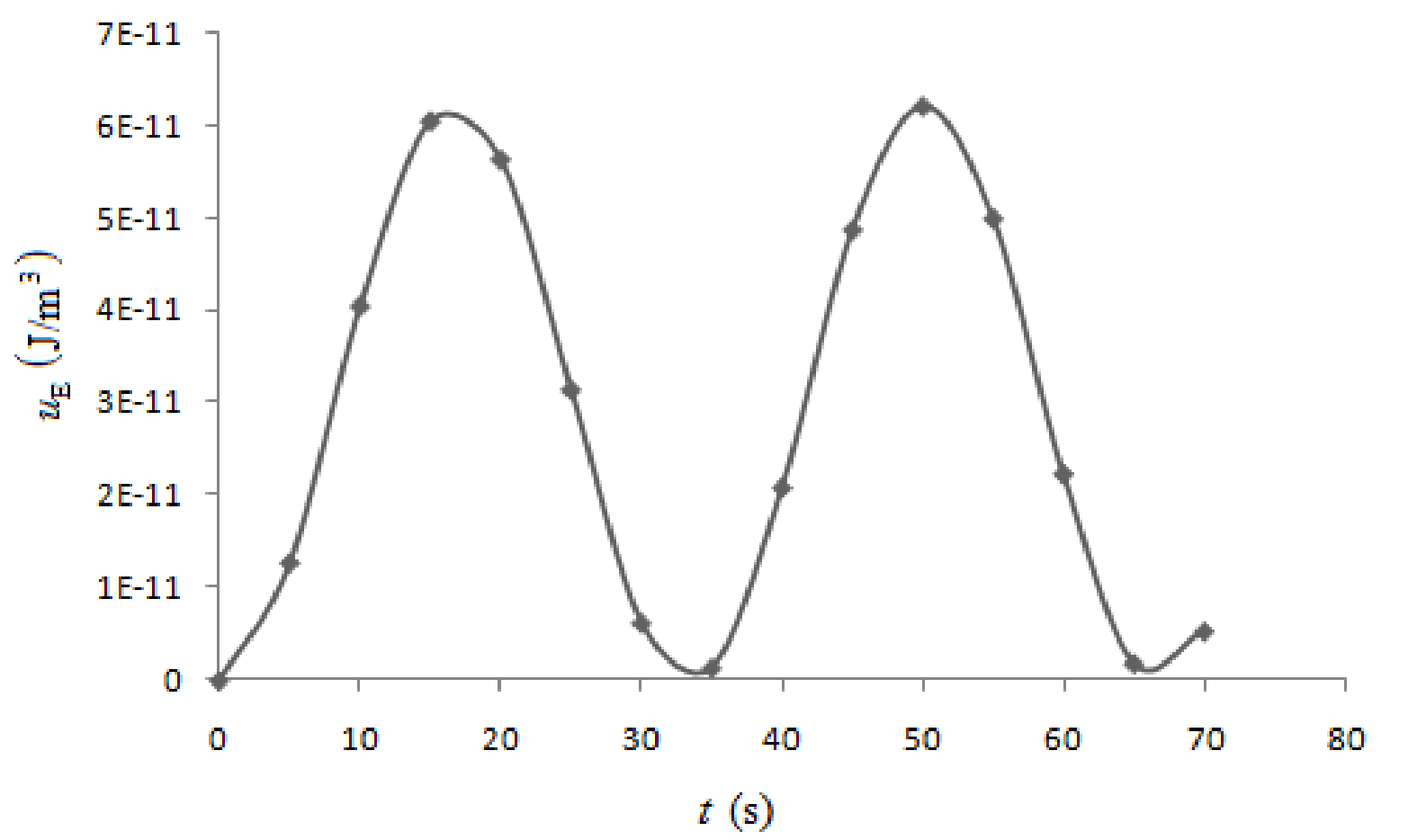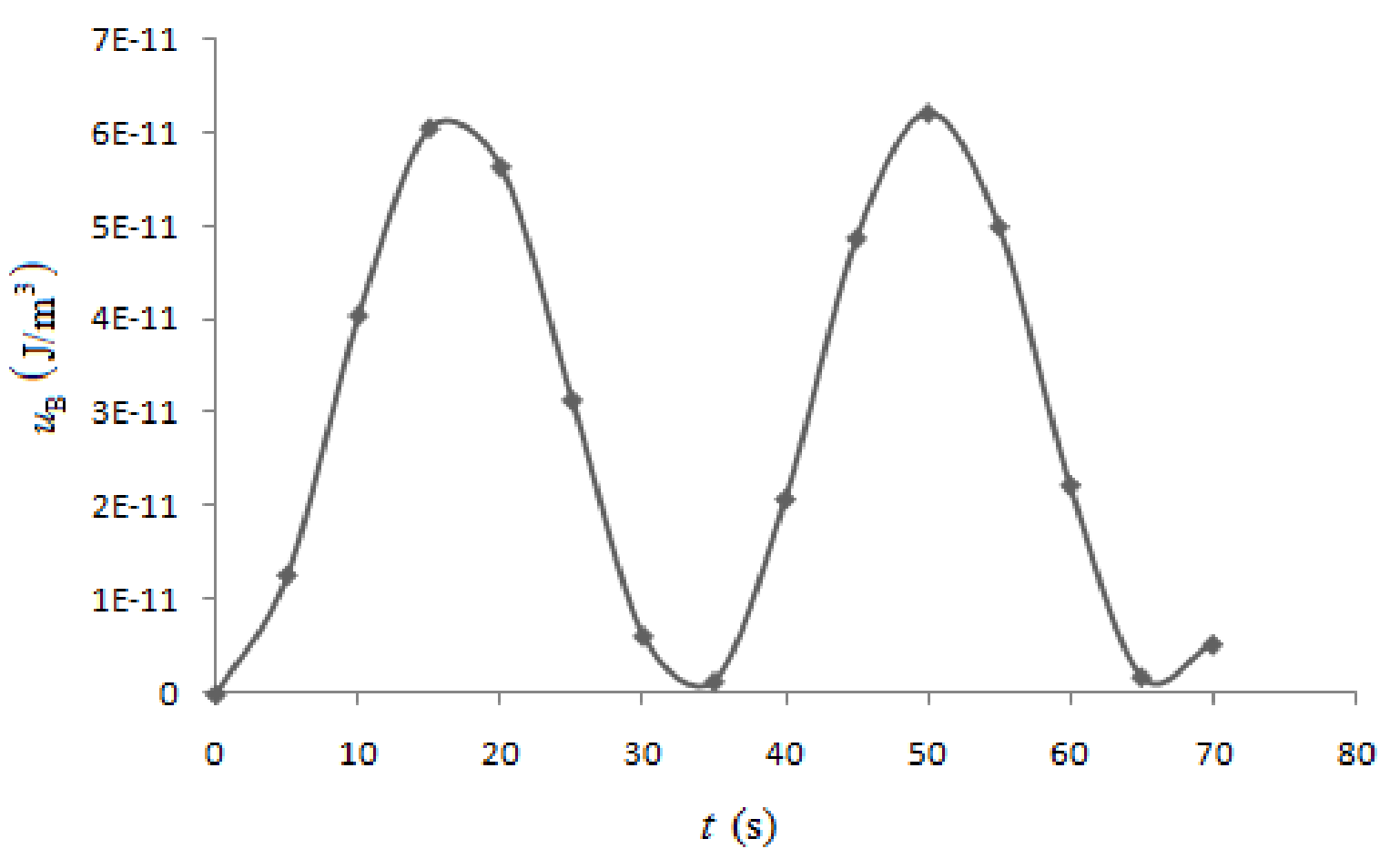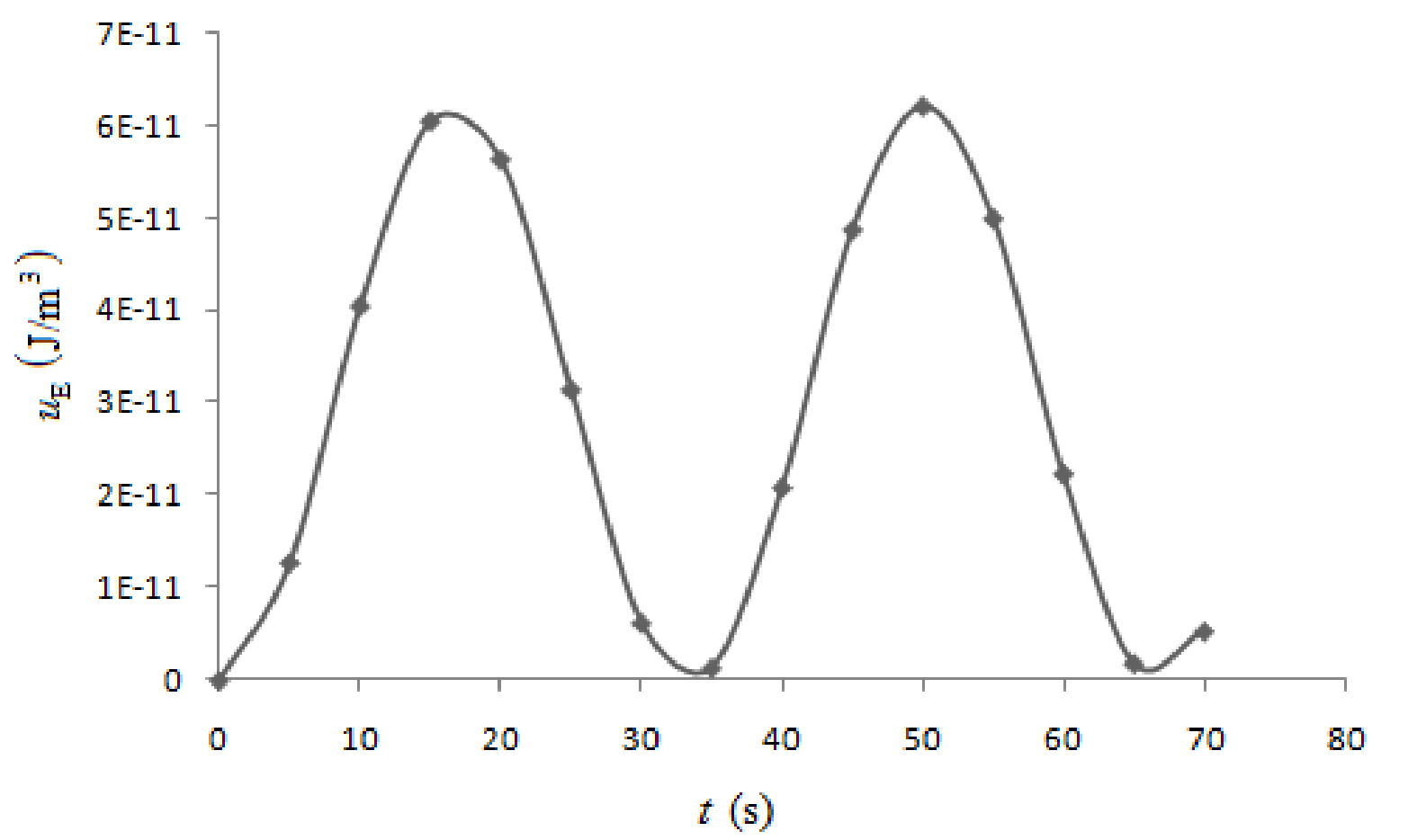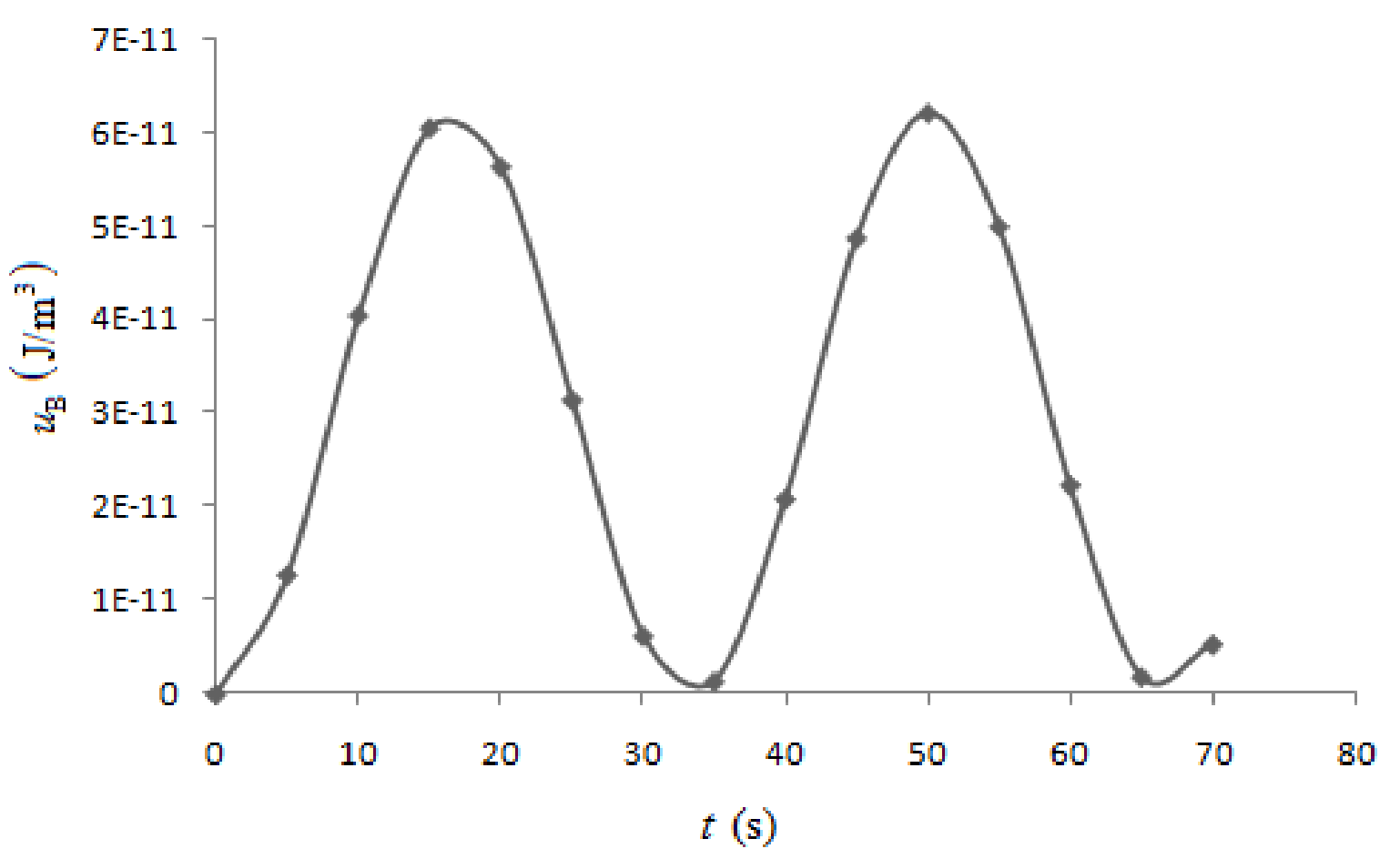
The graph of the magnetic energy density and the electric energy density as a function of time.
Answer to Problem 22PQ
The graph of electric energy density as a function of time is as follows.

Figure-(1)
The graph of magnetic energy density as a function of time is as follows.

Figure-(2)
Explanation of Solution
The electric and magnetic fields vary in space with time
Here,
Write the given expression for the electric field.
Compare the above expression with the equation (I).
Write the expression for the time period
Substitute
Write the expression for electric energy density
Here,
Substitute equation (I) in the above equation and
Calculate the values of
| 0 | 0 |
| 5 | |
| 10 | |
| 15 | |
| 20 | |
| 25 | |
| 30 | |
| 35 | |
| 40 | |
| 45 | |
| 50 | |
| 55 | |
| 60 | |
| 65 | |
| 70 |
Plot the graph by taking

Figure-(1)
Write the expression for the amplitude of the magnetic field.
Here,
Substitute
Substitute
Write the expression for the magnetic energy density of the wave.
Here,
Substitute equation (III) and
Since, the expressions for the electric energy density and magnetic energy density are same. Therefore, the graph for magnetic energy density is same as that for electric energy density.
Hence, the graph for magnetic energy density with time is as shown.

Figure-(2)
Want to see more full solutions like this?
Chapter 34 Solutions
EBK PHYSICS FOR SCIENTISTS AND ENGINEER
- 5. The radius of a circle is 5.5 cm. (a) What is the circumference in meters? (b) What is its area in square meters? 6. Using the generic triangle below, solve the following: 0 = 55 and c = 32 m, solve for a and b. a = 250 m and b = 180 m, solve for the angle and c. b=104 cm and c = 65 cm, solve for a and the angle b a 7. Consider the figure below representing the Temperature (T in degrees Celsius) as a function of time t (in seconds) 4 12 20 (a) What is the area under the curve in the figure below? (b) The area under the graph can be calculated using integrals or derivatives? (c) During what interval is the derivative of temperature with respect to time equal to zero?arrow_forwardPart 3: Symbolic Algebra Often problems in science and engineering are done with variables only. Don't let the different letters confuse you. Manipulate them algebraically as though they were numbers. 1. Solve 3x-7= x + 3 for x 2x-1 2. Solve- for x 2+2 In questions 3-11 solve for the required symbol/letter 3. v2 +2a(s-80), a = = 4. B= Ho I 2π r 5. K = kz² 6.xm= MAL ,d= d 7.T, 2 = 8.F=Gm 9. mgh=mv² 10.qV = mu² 80 12. Suppose that the height in meters of a thrown ball after t seconds is given by h =6+4t-t². Complete the square to find the highest point and the time when this happens. 13. Solve by completing the square c₁t² + cat + 3 = 0. 14. Solve for the time t in the following expression = 0 + vot+at²arrow_forwardA blacksmith cools a 1.60 kg chunk of iron, initially at a temperature of 650.0° C, by trickling 30.0°C water over it. All the water boils away, and the iron ends up at a temperature of 120.0° C. For related problem-solving tips and strategies, you may want to view a Video Tutor Solution of Changes in both temperature and phase. Part A How much water did the blacksmith trickle over the iron? Express your answer with the appropriate units. HÅ mwater = Value 0 ? Units Submit Request Answerarrow_forward
- Steel train rails are laid in 13.0-m-long segments placed end to end. The rails are laid on a winter day when their temperature is -6.0° C. Part A How much space must be left between adjacent rails if they are just to touch on a summer day when their temperature is 32.0°C? Express your answer with the appropriate units. ☐ о μΑ ? D = Value Units Submit Previous Answers Request Answer × Incorrect; Try Again; 3 attempts remaining Al Study Tools Looking for some guidance? Let's work through a few related practice questions before you go back to the real thing. This won't impact your score, so stop at anytime and ask for clarification whenever you need it. Ready to give it a try? Start Part B If the rails are originally laid in contact, what is the stress in them on a summer day when their temperature is 32.0°C? Express your answer in pascals. Enter positive value if the stress is tensile and negative value if the stress is compressive. F A Ο ΑΣΦ ? Раarrow_forwardhelp me with this and the step I am so confused. It should look something like the figure i shownarrow_forwardPart A In an effort to stay awake for an all-night study session, a student makes a cup of coffee by first placing a 200 W electric immersion heater in 0.250 kg of water. How much heat must be added to the water to raise its temperature from 20.5° C to 95.0°C? Express your answer in joules. ΕΠΙ ΑΣΦ Q Submit Request Answer Part B ? J How much time is required? Assume that all of the heater's power goes into heating the water. Express your answer in seconds. VG ΑΣΦ ? t = Sarrow_forward
- help i dont understand this it should look like something like this picture. help me with the stepsarrow_forwardDraw the velocity vectors starting at the black dots and the acceleration vectors including those equal to zero.arrow_forwardYou toss a ball straight up by giving it an initial upward velocity of 18 m/s. What is the velocity of the ball 0.50 s after you released it? Define the positive y direction to be upward, the direction that you toss the ball.arrow_forward
- 10:44 AM Fri Jan 31 O Better endurance Limb end points travel less D Question 2 Take Quiz 1 pt: Two springs are arranged in series, and the whole arrangement is pulled a vertical distance of 2 cm. If the force in Spring A is 10 N, what is the force in Spring B as a result of the displacement? 05N 5 N 0.2 N 10 N O2N Question 3 1 ptsarrow_forwardNo chatgpt pls will upvote Already got wrong chatgptarrow_forwardPlz no chatgpt pls will upvotearrow_forward
 Physics for Scientists and Engineers: Foundations...PhysicsISBN:9781133939146Author:Katz, Debora M.Publisher:Cengage Learning
Physics for Scientists and Engineers: Foundations...PhysicsISBN:9781133939146Author:Katz, Debora M.Publisher:Cengage Learning Principles of Physics: A Calculus-Based TextPhysicsISBN:9781133104261Author:Raymond A. Serway, John W. JewettPublisher:Cengage Learning
Principles of Physics: A Calculus-Based TextPhysicsISBN:9781133104261Author:Raymond A. Serway, John W. JewettPublisher:Cengage Learning
 Glencoe Physics: Principles and Problems, Student...PhysicsISBN:9780078807213Author:Paul W. ZitzewitzPublisher:Glencoe/McGraw-Hill
Glencoe Physics: Principles and Problems, Student...PhysicsISBN:9780078807213Author:Paul W. ZitzewitzPublisher:Glencoe/McGraw-Hill Physics for Scientists and Engineers, Technology ...PhysicsISBN:9781305116399Author:Raymond A. Serway, John W. JewettPublisher:Cengage Learning
Physics for Scientists and Engineers, Technology ...PhysicsISBN:9781305116399Author:Raymond A. Serway, John W. JewettPublisher:Cengage Learning College PhysicsPhysicsISBN:9781938168000Author:Paul Peter Urone, Roger HinrichsPublisher:OpenStax College
College PhysicsPhysicsISBN:9781938168000Author:Paul Peter Urone, Roger HinrichsPublisher:OpenStax College





